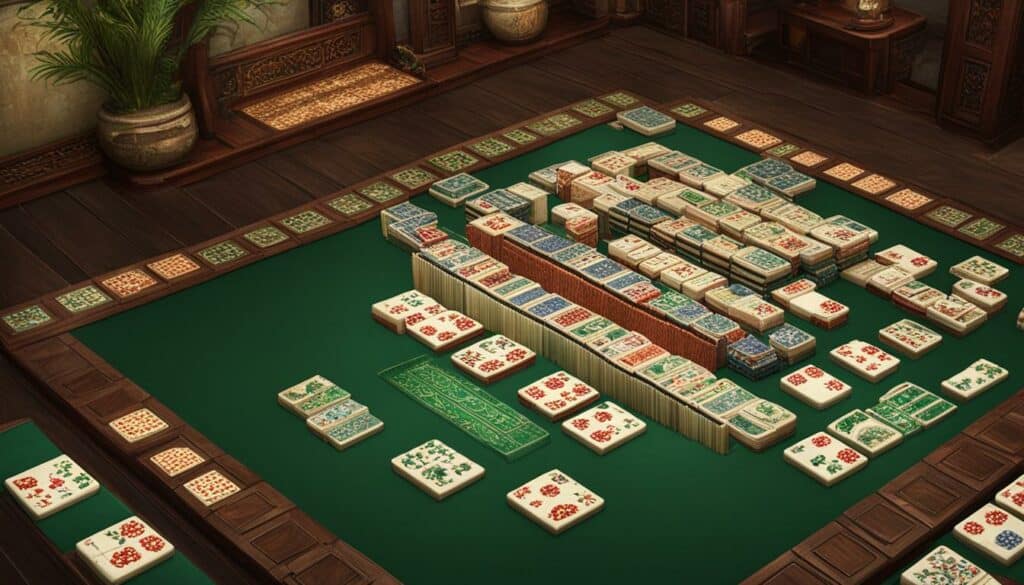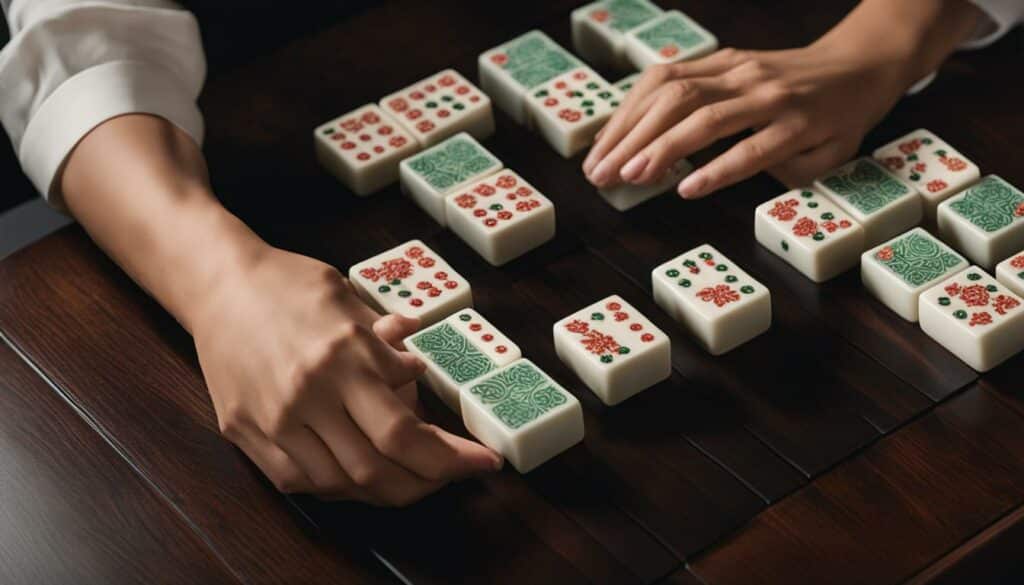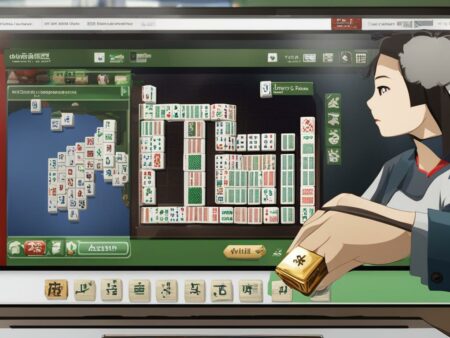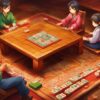Welcome to my comprehensive guide on mastering the rules of playing mahjong in Singapore. Mahjong is a popular tile-based game that has been enjoyed by families and friends in Singapore for generations. Whether you are a seasoned player or just getting started, this step-by-step guide will help you become a master of Singaporean mahjong rules.
You may wonder how to get started if you are new to the game. Don’t worry; I will guide you through every step of the way. But first, let’s get familiar with the basics of mahjong rules in Singapore.

From the number of players to the setup of the tiles, understanding these essential elements will set the foundation for a successful game. Once we have covered the basics, we will move on to building the walls, dealing the tiles, and understanding the game’s objective.
Playing mahjong is not just a game but a social experience that brings people together. So gather your friends, family, or colleagues and start playing today. I promise you won’t be disappointed!
Introduction to Mahjong Rules in Singapore
Hello there! If you’re new to mahjong or looking to brush up on your skills, you’ve come to the right place. In this section, I’ll introduce you to the basics of playing mahjong in Singapore. Let’s get started!
Mahjong is a popular tile-based game in Singapore, and it is usually played with four players. The game consists of several rounds, with players taking turns to make moves. Mahjong is more than just a game; it’s a social experience that brings people together.
Now, let’s talk about the Singapore mahjong rules. Singaporean mahjong is played with a traditional set of 144 tiles divided into different suits, including dots, bamboo, characters, winds, and dragons. These tiles are shuffled and stacked to form a wall, and players take turns building walls and rolling dice to determine the starting point.
Once the wall is complete, the tiles are dealt out to the players, and the game begins. The goal in mahjong is to form sets and runs with the tiles in your hand. Sets can consist of three identical tiles or a sequence of three consecutive tiles in the same suit. The player who completes a winning hand first by forming the required sets and runs wins the round.
Now that you have a basic understanding of the rules of Singapore mahjong let’s move on to setting up the tiles in the next section.
Getting Started with Mahjong
Before we begin playing mahjong, knowing how to set up the game is important. A traditional mahjong set comprises 144 tiles divided into different suits, including dots, bamboo, characters, winds, and dragons.
After the tiles are sorted by suit, they are then shuffled and stacked on a wall. Players take turns building walls and rolling dice to determine the starting point for dealing the tiles.
Once the starting player is chosen, tiles are dealt to each player in a specific pattern. Depending on the mahjong variant being played, each player may receive either 13 or 16 tiles to start with.
It is important to note that certain tiles have a special significance in mahjong. Winds and dragons, for example, are considered special tiles that can be used to form certain sets and runs.
Players must also be familiar with the specific rules of the variant they are playing. Some variants may have particular scoring factors or gameplay mechanics, so clarifying any rules before starting the game is essential.

Once the game starts, players take turns drawing and discarding tiles to form sets and runs. As each player takes their turn, the wall of tiles slowly dwindles until the winning hand is formed, and the game ends.
The Table Setup
The table should be large enough to fit the tiles and must accommodate four players. A standard table size for mahjong is approximately 34 inches by 34 inches.
The table should also have enough space for each player to place discarded tiles and a space for the wall of tiles to be built.
It is also important to establish a clear set of rules for communication during the game. Players must agree on what kind of non-verbal signals can be used to communicate with the other players.
Conclusion
Setting up a mahjong game may seem complicated at first, but it becomes second nature with practice. Familiarizing yourself with the basic elements of a traditional mahjong set and the specific rules of the variant you are playing is essential to success.
It’s time to start playing once you have everything set up and ready to go. In the next section, we will dive into the gameplay itself and explore the dynamics of taking turns, drawing and discarding tiles, and declaring a win.
Understanding the Aim of the Game
Now that we have set up the game, it’s time to understand the objective of mahjong. The goal is to form sets and runs with the tiles in your hand to compete against other players and become the first to complete a winning hand. A set can consist of three identical tiles, such as three 7 of bamboo tiles, or a sequence of three consecutive tiles in the same suit, such as 1, 2, and 3 of dots. The player who completes a winning hand first by forming the required sets and runs wins the round.
It’s important to note that there are different types of winning hands, and some include specific combinations of tiles. For example, a winning hand can be formed with all three dragon tiles or all four winds. These combinations are known as ‘honours,’ and they add to the overall value of the winning hand.
It’s also worth mentioning that a winning hand can be declared in several ways. A player can declare “mahjong” if they have a complete hand of 14 tiles and can form a winning combination. Alternatively, a player can declare a win by “going out,” which means that they have one tile remaining in their hand after forming a winning combination, known as a “self-drawn win.”
Examples of Winning Hands
| Winning Hand Type | Description |
|---|---|
| Mahjong | A complete hand of 14 tiles with a winning combination |
| Self-drawn win | One tile remaining in hand after forming a winning combination |
| Dragon Pung | Three dragon tiles of the same type and a pair of the same dragon tile |
| Mixed Shifted Chows | Three chows of the same suit in sequential order with one tile of a different suit in between each chow |

Keep in mind that strategy and skill are essential in mahjong, and understanding the aim of the game is just the beginning. With practice and experience, you can learn to recognize different tile patterns and anticipate other players’ moves, increasing your chances of forming winning combinations and ultimately winning the game. So, let’s move on to the next section and start playing!
Playing the Game
Now that we have a solid understanding of the mahjong rules in Singapore, it’s time to learn how to play the game. Let’s go through the essential aspects of gameplay, from taking turns to declaring a win.
Taking Turns
In mahjong, players take turns to make moves, following a counterclockwise direction. With each turn, a player can either draw a tile from the wall or claim another one. Once a player draws a tile, they must discard a tile face-up in the center of the table.
Drawing and Discarding Tiles
The wall consists of tiles stacked in a square, and players can draw a tile from either end of the wall. When discarding tiles, make sure to place them facing upwards so that other players can see them.
Claiming Tiles
Players can sometimes claim a tile discarded by another player to form a set or run. To claim a tile, a player must declare the name of the tile and the set/sequence they are forming.
Declaring a Win
Mahjong aims to form the required sets and runs to complete a winning hand. When a player has formed a winning hand, they must declare it by saying “Mahjong” and placing their tiles face-up on the table. The other players will verify the winning hand before moving on to the next round.

As you can see, the gameplay is relatively simple once you get the hang of it. The key is to stay focused and attentive to the tiles on the table so you don’t miss an opportunity to form a winning hand. Good luck!
Scoring and Ending the Game
The gameplay begins once all the tiles have been dealt, and players take turns drawing and discarding tiles. The first player to complete a winning hand by forming sets and runs with their tiles wins the round.
But how are points awarded, and how does a game end? Let’s take a closer look at the scoring system in Mahjong.
The Scoring System
In mahjong, points are awarded based on the value of the winning hand and specific combinations. The winner receives points from each of the other players, with the total number of points determined by the pre-agreed value of each point.
Each type of win has a different point value. For example, a self-drawn win (meaning the player completes their hand without any discards from other players) is worth more points than a win from a cull.
Additionally, specific combinations of tiles can increase the point value of a win. These combinations are known as ‘yaku’ and include things like a pure triple-chow or a winding pair.
Continuing the Game
After each round, the player with the most points becomes the ‘dealer’ for the next round. The game continues until a pre-determined number of rounds or points has been reached.
It’s important to note that players may continue to play in some game variations even if they have already reached the pre-determined number of points. In this case, the winner is the player with the most points at the end of the final round.

Now that you understand the scoring system in mahjong, you’re ready to put your new skills to the test. Remember, the ultimate goal of mahjong is not just to win but to enjoy the social experience and have fun with your fellow players.
Conclusion
Now that you have learned the ins and outs of Singaporean mahjong rules, you can enjoy playing this popular tile-based game with your friends and loved ones. With four players taking turns to make moves, you can enjoy this social game for several rounds.
Remember that mahjong is a game and an opportunity to socialize and connect with others. So, gather your friends, shuffle the tiles, and let the games begin!
Whether you’re a seasoned player or just getting started, the strategies and techniques outlined in this step-by-step guide will help you master the game. Enjoy the thrill and excitement of this traditional game that many have enjoyed for generations.
So, what are you waiting for? Dive in, have fun, and experience the joy of playing mahjong in Singapore!



















